BBQ Legend Mike Mills Shares Cookout Tips
Father-daughter team barbecue legend Mike Mills and Amy Mills of 17th Street Barbecue sit down with Fox News’s Lilian Huang Woo to talk the best way to talk amazing ribs, burgers and more.
Take a LISTEN:
CARAMELIZED MIDWEST PORK STEAKS
Pork steak is a Midwest classic that most home cooks just grill, which is a fine way to get good outdoor flavor from an inexpensive cut of meat. But we give ours a special reverse-sear treatment: first dusting the steaks lightly with dry rub, then infusing with the gentle smoke of apple wood, next grilling, and finally mopping with sauce and caramelizing them over direct fire.
As commonplace as they are in the Midwest, pork steaks are not usually found in grocery meat cases elsewhere, but obtaining them is as easy as asking your butcher to cut them from the butt end of a pork shoulder—specify 1-inch-thick steaks that weigh about a pound apiece, since this is the optimal size for taking on smoke. The steaks can be smoked a day or two in advance and finished on the grill just prior to serving. You can even freeze a pile of smoked steaks for up to 1 month, then pull them out, thaw, and grill them as needed.
MAKES 4 TO 6 SERVINGS
4 to 6 bone-in pork steaks (about 1 pound each)
Pure Magic dry rub (SEE BELOW) or your choice
Apple City Barbecue Sauce (SEE BELOW), or your choice, warm
1 to 3 pounds good quality lump charcoal
1 small (8-inch) piece of apple wood or 2 store bought chunks
String mop (An old-fashioned string mop captures the most sauce and distributes it evenly over the meat.)
Lightly sprinkle the pork steaks with dry rub on both sides. Set the steaks on a baking sheet, cover them with plastic wrap, and refrigerate until you’re ready to put them on the cooker.
Note: You can dust the steaks with dry rub up to 4 hours prior to cooking, but if the steaks sit any longer than that, the salt in the rub will begin to pull moisture from the meat.
Set up the cooker for indirect-heat smoking: Open the top and bottom vents. Load a charcoal chimney one-quarter full of charcoal and light it. When the coals in the chimney are glowing, dump them on one side of the cooker. Set the wood on top of the coals, replace the grate, and put the steaks over the side with no coals (the indirect cooking area). Close the lid.
Don’t open the cooker for 15 minutes, but keep a close eye on the temperature; when it reaches 200°, which might happen very quickly, close the vents about halfway so that less air comes in to feed the fire and the heat in the cooker rises slowly. Let the temperature climb to between 225° and 250° (see page 77 for how to determine your target temperature). Maintain your target temperature; if at any point it climbs above your target, close the top and bottom vents further so that even less air comes in to feed the fire.
After 15 minutes, use an instant-read thermometer to check the internal temperature of the meat: Insert the probe into the center of one of the steaks, not near the bone. You are looking for a slow and steady climb to between 160° and 165°. Do not flip the steaks over at all during the smoking stage.
After you check the meat temperature, reload the chimney halfway with charcoal and light it. You’ll soon need these additional hot coals to sear the steaks at the finishing stage, after they’re done smoking.
Check the internal temperature of the meat every 10 minutes or so. When the steaks are between 160° and 165°, pull them off the cooker and set them aside on a baking sheet. Working quickly, add the hot coals, spreading them out all over the bottom of the cooker. Lightly mop the tops of the steaks with the barbecue sauce, sprinkle on a light layer of dry rub, and put the steaks back on the cooker, sauce side down, directly over the hot coals. Cook the steaks for 5 to 8 minutes, mopping with the sauce and flipping them several times to caramelize all over. If there are spots of fat that are dark and blackened, sauce them and caramelize them again. When the steaks are sizzling around the bone and beautifully glazed on both sides and around the edges, they’re done. The internal temperature should be between 170° and 175°.
PURE MAGIC
MAKES ABOUT 2 ¼ CUPS
For our favorite rub, the spices are ground to a fine powder; you’ll need a spice mill or coffee grinder. Spice particles that are all the same size create a rub that melts when used on meat. No one flavor will predominate, and you won’t feel gritty spice particles when you’re eating. The combination of spices is savory, with just a little sweetness. Use leftover rub as called for in a variety of recipes in this book. You’ll also find yourself reaching for this well-balanced all-purpose rub for all kinds of meat, as well as fish, vegetables, french fries, and popcorn.
1/2 cup sweet Hungarian paprika
1/4 cup kosher salt
1/4 cup sugar
1/4 cup granulated garlic
1/4 cup chili powder
1/4 cup ground cumin
1 tablespoon dry mustard
1 tablespoon coarsely ground black pepper
1 teaspoon cayenne pepper
Mix all the ingredients. Using a spice mill or coffee grinder, blend 1/4 cup at a time to a powder-like consistency so that all of the spice particles are relatively the same size. Store in a tightly covered container in a cool, dark place. The rub keeps for about 6 months, or until the color or pungent aroma fades.
Variation: To make this rub a little spicier, increase the mustard and black pepper to 2 tablespoons each.
APPLE CITY BARBECUE SAUCE
MAKES ABOUT 2 CUPS
This is the sauce that has won us dozens of awards and accolades on the competition circuit. It’s a harmonious combination of ketchup, vinegar, and mustard—the three ingredients that typically set regional barbecue styles apart from one another—along with fresh grated apple, a nod to the apple orchards surrounding Murphysboro. This sauce is a favorite on ribs and pulled pork sandwiches, as well as on chicken and hamburgers.
3/4 cup ketchup (made with cane sugar, such as Red Gold or Hunt’s)
2/3 cup rice vinegar
11/2 cups apple cider
1/4 cup apple cider vinegar
1/4 cup packed light brown sugar
1/4 cup Worcestershire sauce
2 teaspoons prepared yellow mustard
1/2 teaspoon granulated garlic
1/8 teaspoon ground white pepper
1/8 teaspoon cayenne pepper
1/3 cup bacon bits (real, not imitation), ground in a spice mill
1/3 cup grated peeled apple
1/3 cup grated onion
2 teaspoons grated green pepper
Combine the ketchup, rice vinegar, apple juice, cider vinegar, brown sugar, Worcestershire sauce, mustard, granulated garlic, white pepper, cayenne, and bacon bits in a large saucepan. Bring to a boil, stir in the apple, onion, and green pepper, then lower the heat. Simmer the sauce, stirring often, for 10 to 15 minutes, until it thickens slightly. Decant into a mason jar, cover, and refrigerate; the sauce will keep for at least a month. Warm or bring to room temperature before serving.
Variation: To make this sauce a little hotter, add more cayenne pepper to taste, another 1/4 to 1/2 teaspoon. Be careful; a little goes a long way.
PRAISE THE LARD by Mike Mills and Amy Mills. Copyright © 2017 by Mike Mills and Amy Mills. Used by permission of Rux Martin Books / Houghton Mifflin Harcourt. All rights reserved.









